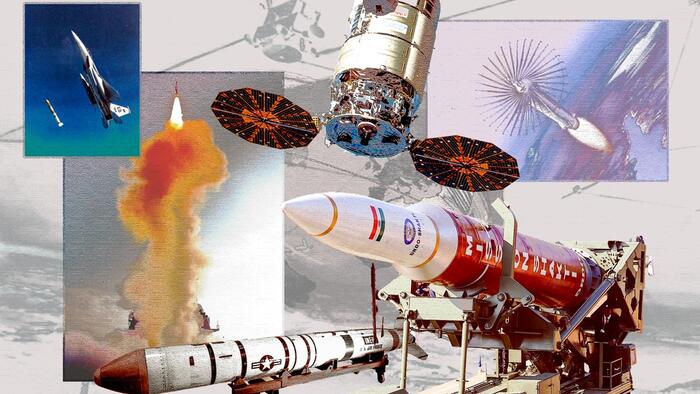Space, often referred to as the final frontier, is increasingly becoming a focal point for national security as countries emphasize the military potential of low Earth orbit. Experts highlight a growing trend where governments, particularly the United States, are consolidating their efforts in enhancing space defense capabilities and utilizing space as a potential battlefield. Evan Ellis, a defense analyst and research professor at the U.S. Army War College, underscores the importance of expanding and safeguarding space infrastructure from a national defense viewpoint. He asserts that recognizing space as a critical warfighting domain obliges nations to adopt effective measures for protecting their assets during conflict, especially given the complex and multifaceted nature of warfare in space.
Ellis discusses the various weapons that could be deployed in space, distinguishing between kinetic weapons such as missiles, and non-kinetic options including electromagnetic pulses, microwaves, and lasers. While he acknowledges the technological underpinnings that make these weapons plausible in space, he identifies varying levels of practicality depending on the combat scenario. For instance, he explains that while laser weapons present distinct advantages, their effectiveness can be limited by energy supply issues, making kinetic weapons more appropriate for specific targets like underground bunkers. He concludes that the focus for space warfare should instead be on engaging celestial targets rather than ground-based objectives, advocating for the development of capabilities that allow space-based systems to effectively neutralize other space objects.
In tandem with advancements in military capabilities, the emergence of anti-satellite (ASAT) weapons has escalated concerns about space security. Irina Tsukerman, a national security lawyer and president of Scarab Rising, emphasizes that countries such as China and Russia have made significant strides in developing ASAT systems, demonstrating their ability to disable or destroy U.S. satellites. This growing proliferation of ASAT capabilities causes trepidation among nations, especially with the evident rise in counter-space technology investments and deployments. The Atlantic Council’s analysis raises alarms, noting that while destructive ASATs are not yet actively utilized in conflict, the demonstration of their capabilities by several nations—including tests where they destroyed their own satellites—illuminates the hazardous potential of these technologies as global reliance on space increases.
Investment in military space capabilities has surged, with the Space Foundation reporting an 18% rise in global military space budgets this year alone, indicating that defense spending in this sector constitutes nearly half of the total government space spending. The United States represents a significant portion of this investment, claiming 80% of the military space budget, though countries like Japan and Poland have also ramped up their expenditures in space defense. This financial commitment by nations reflects a recognition of the strategic importance of space in contemporary and future conflicts against a backdrop of geopolitical tension with major powers like Russia and China.
Additionally, the militarization of space raises concerns that challenge the framework laid out by the United Nations’ Outer Space Treaty, which has prohibited the placement of nuclear weapons and weapons of mass destruction in space since 1967. While the treaty still has numerous signatories, initiatives from organizations like the Center for Arms Control and Non-Proliferation highlight that the increase in military endeavors could undermine existing agreements as militaries expand into forbidden territory. The treaty’s limitations have allowed current military arsenals to focus primarily on Earth-to-space technologies, but some analysts suggest that growing interests in space-to-space and space-to-Earth weapons might lead to an inevitable expansion into these areas—fueled by the rising congestion in space and evolving military strategies.
The classification of space weaponry falls into categories including Earth-to-space, space-to-space, and space-to-Earth systems, with recent reports indicating that over half of the militaries globally have started developing counter-space technologies. Experts from the Center for Strategic and International Studies (CSIS) identify four specific types of space weaponry: kinetic physical, non-kinetic physical, electronic, and cyber. Recent analyses from the Secure World Foundation caution that nations aiming to counteract the strategic advantages of rivals are integrating cutting-edge technologies into military frameworks to secure their positions in space and to deter potential aggression. The U.S. military recognizes that maintaining its competitive edge hinges upon advancements in these technologies, especially in light of growing threats from competitors like Russia who are also keen on enhancing their space-based capabilities.
In summary, as the geopolitical landscape shifts, the militarization and exploration of low Earth orbit have emerged as pivotal issues in contemporary national security discourse. The confluence of technological advancements, increased investments in counter-space measures, and potential breaches of existing treaties paints a complex picture of future warfare dynamics. Nations must navigate the delicate balance between maintaining military readiness and adhering to international agreements, all while fostering an environment that encourages peaceful exploration of space amidst rising tensions and competition among world powers.

